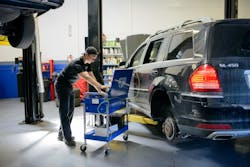In the weeks leading up to the ADAPT Summit, a three-day conference in December in Nashville focusing on the most pressing and progressive trends facing the automotive industry, FenderBender's sister publication, ADAPT Automotive, will spend time talking to some of the keynote speakers and other presenters about the topics they plan to discuss. Some of the interviews that apply to collision repair will be published on FenderBender as well.
Mark Fincher, marketing solutions vice president for CCC Intelligent Solutions, spoke to Digital Multimedia Editor Noah Brown about how important it is for aftermarket shops to have access to new repair information and tools, and what role companies such as CCC play in getting shops what they need.
This interview has been lightly edited for brevity and clarity. To listen to the full interview, check out the podcast link included in the story below.
ADAPT: What are you all hoping to cover at the Summit?
Mark Fincher: There are a few things that we want to talk about. First, just the blistering pace at which new technologies are being introduced into the marketplace, especially for our collision repair facility customers as well as insurers. Second, AI is at the center of a lot of that technology, and it's helping create a more seamless end-to-end process, not just for the the users themselves but also for the customer.
Through the past 18 months to two years of COVID now, consumers have become more and more accustomed to a very transparent, self-service type of experience, (and AI is helping) to create those same experiences as part of a claim or part of a collision repair. That allows our customers to compete, because that's what customers expect today. We've talked in the past about liquid expectations over the years and how customers’ expectations are carrying over from one industry to the other, and that's never been more true than it is today.
There's been an explosion of technology in the past five years or so, and although a lot of that attention is placed on emerging technology in vehicles, major advancements have also been made in how vehicle information is being shared. What has CCC been working on in that time in regards to sharing information?
So there are two key things that we've been working on, one for quite some time now. We've been working on bringing OEM repair procedures to the forefront of collision repair and making it easier for collision repairs to get access. Those OEM procedures are complex and ever-changing. It's one thing to have access to them, but it's another thing to actually get people to go look at them.
Quite some time ago we launched CCC Repair Methods, and we brought repair procedures into the estimating solution. So it was easy for front-end workers, especially estimators, to be able to link out to a repair procedure as they're writing the estimate so they can understand exactly what needs to be done per the procedures. We've continued to make investment in that. And over the past year and a half, we've been working on our next big release of that, where we're making that information even more readily available
The second piece that we talk about a lot is diagnostics. At CCC, we saw a need many years ago to integrate diagnostics into the workflow of the repair. And so we've been doing a lot of work to bring that diagnostics functionality so it's all part of the workflow for the shop part of the work files.
How important is it for aftermarket shops to have access to new information and tools from OEMs, and what role do you at CCC see yourselves playing in getting that information to shops?
Yeah, that's a great question. It's more important now than ever before that shops have access to information about the construction of the vehicle, about the proper repair of the vehicle. OEMs have been doing a great job getting that information out, but that information is extensive.
I've heard anecdotally that if you really want to do it right, it could take six to eight hours to research a larger repair, all the procedures and really read through all the documentation. There could be a couple hundred pages of documentation from the OEM on a larger repair.
Making that information readily available and making it easy to access has been a goal of ours for quite some time, and that is exactly why we've integrated it into CCC One and why we're making this additional investment to make it even easier. And, just as importantly, to make it up as up-to-date as possible because it does change, and knowing what those changes are is really critical to make sure that repairs are restoring a vehicle to its pre-accident condition per the OEM recommendations.
Now more than ever before, as vehicle complexity is changing not only on a year-by-year basis but even within model years, we're seeing changes in production lines for certain vehicles where they're making changes to the construction of the vehicle, understanding those procedures is really critical.
What are one or two major takeaways that you want people to get from your Summit presentation?
One is AI, and more specifically what AI is and what AI is not. I think there's a lot of misconception around what AI is, both positive and negative. I wanted to dispel some of the myths around AI and make sure that everyone really understands what it is and what it's not.
The second is around the customer experience. I think the way that we dealt with customers even two years ago, five years ago, 10 years ago is not going to work going into the future. I want to talk to collision repairers about what those modern customer expectations are, how AI is going to impact that and other tools that repairers can use to create more transparency.
How optimistic are you for the automotive aftermarket going into the next decade?
I think these changes in technology are exciting. I think it provides an opportunity for us to bring new talent into the industry, which is something that's desperately needed.I think it creates a lot of opportunity for collision repairers that are willing to embrace it, that see the technology as an opportunity to take their business to the next level. I think there's a lot of excitement around it.
There’s also a lot of learning that needs to be had as well, and conferences like (the ADAPT Summit) are going to be great for repairers to attend. They can really set themselves apart and start thinking about what they need to do to change their business and adapt for the future.
About the Author

Noah Brown
Noah Brown is a freelance writer and former senior digital editor for 10 Missions Media, where he facilitated multimedia production several of the company's publications.
